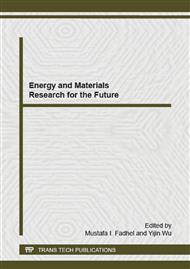[1]
Lee S C. Prediction of concrete strength using artificial neural networks [J]. Engineering Structures, 2003, 25(7): 849-857.
DOI: 10.1016/s0141-0296(03)00004-x
Google Scholar
[2]
Lai S, Serra M. Concrete strength prediction by means of neural network [J]. Construction and Building Materials, 1997, 11(2): 93-98.
DOI: 10.1016/s0950-0618(97)00007-x
Google Scholar
[3]
JGJ55-2000, Design regulations of mix ratio of ordinary concrete [S]. Beijing: China Architectural & Building Press, 2010, 2001. (in Chinese).
Google Scholar
[4]
Cheng Yan. Mix design and performance study of high-strength lightweight aggregate concrete [D]. Jingling University, 2007(in Chinese).
Google Scholar
[5]
Chao Gang. Experimental study on high strength lightweight aggregate concrete [D]. Northwestern Polytechnigal University, 2004(in Chinese).
Google Scholar
[6]
Cheng Ling. Design of mixture proportions and study on performance of LC50 lightweight aggregate concretes [D]. Changsha University of Science & Technology University, 2013(in Chinese).
Google Scholar
[7]
Guo Hongyun. Design of mixture ratio of pottery grain concrete[J]. Engineering Journal of Wuhan University 2007, 40: 522-525. (in Chinese).
Google Scholar
[8]
Li Wenbin. Research on the light-weight haydite aggregate concrete [D]. Xian University of Architecture and Technology, 2012(in Chinese).
Google Scholar
[9]
Yu Xiao. Research on high-strength shale aggregate's preparation and property for aggregate concrete [D]. Chongqing University, 2004(in Chinese).
Google Scholar
[10]
Li Pingjiang , LIU Xunbo. Fundamental mechanical properties of concrete with high strength expanded shale. [J]. Journal of Building Materials 2004, 7(1): 113-116. (in Chinese).
Google Scholar
[11]
Li Jingyong. Orthogonal test of LC40 boron mud ceramsite concrete. [J]. Journal of Shenyang Jianzhu University ( Natural Science) 2014, 30(3): 401-497. (in Chinese).
Google Scholar
[12]
Qu Shuqiang. Experimental study on the mechanical properties of fly ash ceramic concrete and slab [D]. Inner Mongolia University of Science and Technology, 2012(in Chinese).
Google Scholar
[13]
Wang Xuan, Wang Lei. Shale Ceramsite concrete mix design and performance experimental study . [J]. Sichuan Building Materials, 2012, 38(5): 16-17. (in Chinese).
Google Scholar
[14]
Li Chuanlin, Sun Kaishuang and Liu Guibin. Study on mix propertion of lightweight aggregate concrete . [J]. Ready-mixed Concrete, 2014, 4: 50-54. (in Chinese).
Google Scholar
[15]
Yang Yi. Research on the certain behavior of ceramstie concrete and the member's degree of carrying capacity reliablity [D]. Changsha University of Science and Technology, 2012(in Chinese).
Google Scholar
[16]
Shen Huayu , Wang Zhaoxia and Gao Chengyao. Determining the number of BP neural network hidden layer units. [J]. Journal of Tianjin University of Technology 2008, 24(5): 13-15. (in Chinese).
Google Scholar


